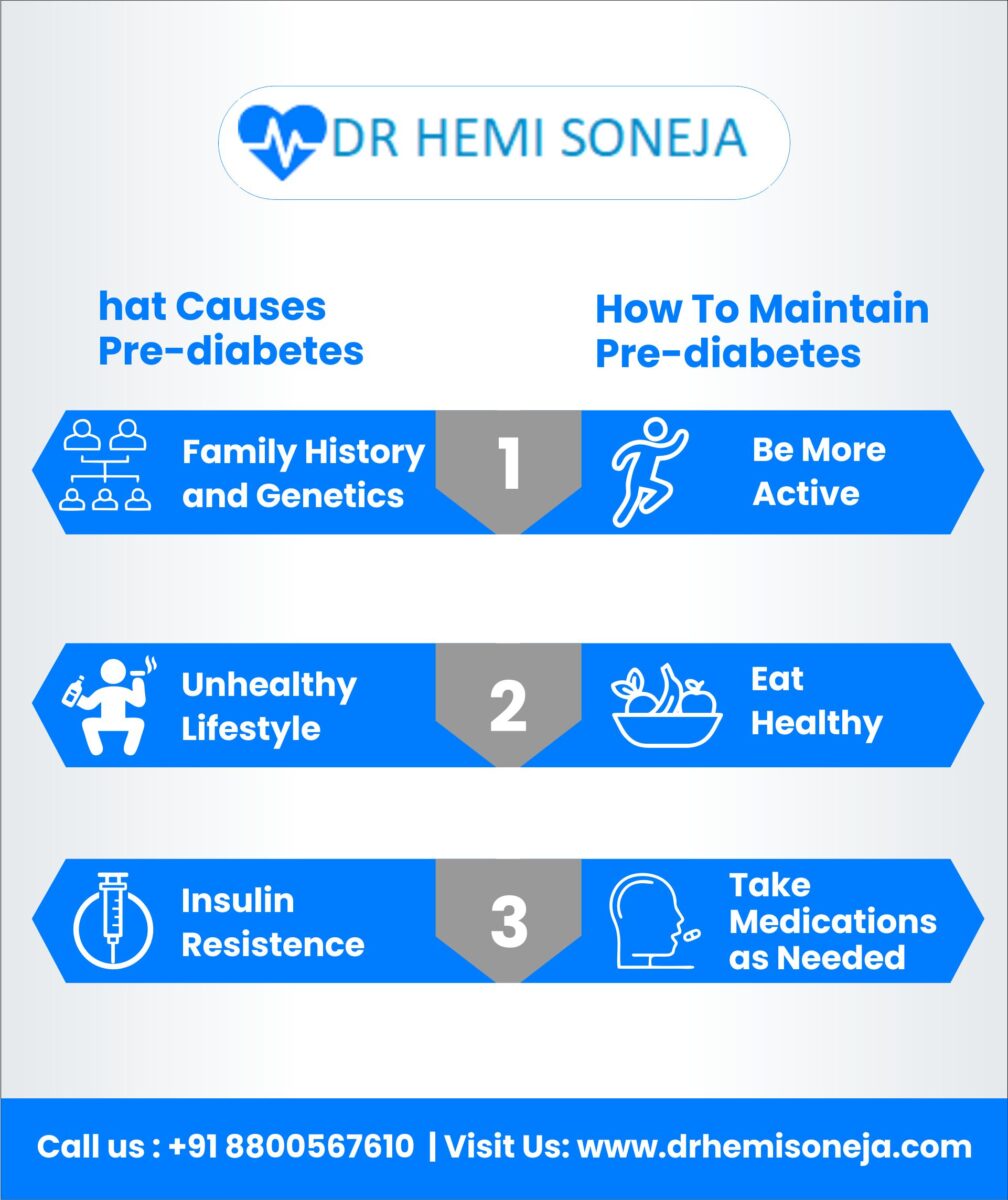When you are prediabetic, your blood glucose levels are higher than normal but are not high enough to be regarded as a diabetic condition. As the name suggests, it is the beginning of diabetes, where the high glucose levels could have started to begin the long-term effects of diabetes- particularly on the heart, kidneys, blood vessels, and other organs.
According to the Centres for Disease Control and Prevention (CDC), a fasting blood sugar level of 99 mg/dL or lower is normal; 100 to 125 mg/dL indicates prediabetes, and 126 mg/dL or higher indicates diabetes. However, the progression of prediabetes to diabetes can get inevitable without lifestyle modifications, dietary changes, and a regular exercise regime.
Table Of Content
-
What is Prediabetes?
-
What are the Symptoms of Prediabetes?
-
What does Prediabetes Diagnosis involve?
-
What are the Treatment and Management Options for Prediabetes?
-
FAQs
-
Conclusion
People with prediabetes need to make a healthy diet and physical activity a part of their routine. These changes in daily practices can help prevent type 2 diabetes progression and can help normalise their blood sugar levels.
This article discusses everything you need to know about prediabetes and what you should do if diagnosed with prediabetes.
What is Prediabetes?
Insulin, an essential hormone produced by the pancreas, modulates blood glucose levels by enabling cells to use them for energy. According to the CDC, prediabetes is when the cells in the body do not respond properly to insulin, i.e., the cells develop insulin resistance.
The pancreas, in turn, tries to produce more insulin. But, eventually, the pancreas cannot keep going, and blood sugar levels rise, causing prediabetes and diabetes in the long run.
The pancreas, in turn, tries to produce more insulin. But, eventually, the pancreas cannot keep going, and blood sugar levels rise, causing prediabetes and diabetes in the long run.
A prediabetic condition can put one at a higher risk of developing type-2 diabetes mellitus. Hence, preventing the progression of prediabetes to diabetes is crucial.
What are the Symptoms of Prediabetes?
People with prediabetes usually do not experience any signs or symptoms. However, one noticeable sign is the presence of darkened skin patches on certain body parts, including the neck, armpits, and groyne.
Some other signs of prediabetes to look out for include:
- Feeling thirsty more frequently,
- Frequent urination,
- Blurry vision,
- Fatigue or general weakness,
- Increased hunger,
- Unintended loss of weight,
- Tingling or numbness in the hands and feet,
- Increased frequency of infections,
- Sores and wounds that heal slowly.
If you observe any of the above signs and symptoms, you must visit your physician to get a blood glucose test.
What does Prediabetes Diagnosis involve?
The American Diabetes Association (ADA) recommends diabetes screening for adults above the age of 45. And if you are having overweight issues or additional health conditions, the screening age can be below 45. Here are some blood tests recommended for prediabetes, with their optimal, diabetic, and prediabetic values.
Condition |
Glycated Haemoglobin A1C Test |
Fasting Blood Sugar Test |
Glucose Tolerance Test |
Random Blood Sugar Test |
Diabetes |
6.5% or above | 126 mg/dL or above | 200 mg/dL or above | 200 mg/dL or above |
Prediabetes |
5.7 – 6.4% | 100 – 125 mg/dL | 140 – 199 mg/dL | N/A |
Normal |
Below 5.7% | 99 mg/dL or below | 140 mg/dL or below | N/A |
Diabetes is getting more common among children with obesity issues. And so, ADA recommends childhood diabetes screening for children having one or more of the following risk factors.
- Having a family history of type 2 diabetes,
- Ethnicity-related risk of diabetes,
- A child born with low weight at birth,
- A child born to a mother having gestational diabetes.
The screening test ranges are the same for children as adults. Children and adults with prediabetic conditions must undergo regular tests.

What are the Treatment and Management Options for Prediabetes?
Healthy lifestyle choices can help keep blood sugar levels normal and prevent them from rising or progressing to type 2 diabetes. Here are some dietary and exercise tips that can help manage prediabetic conditions in adults and children
Have healthy food choices
Having high nutrient-content- fruits, vegetables, nuts, whole grains, low fat, and low carbohydrate/ sugar foods can lower the risk of prediabetes. Foods low in calories, glycemic index, and high in fibre are essential to achieve your goal of maintaining optimum sugar levels. Reduced portion sizes, increased meal frequency, plenty of water intake, with lesser consumption of junk/ fast foods can make a difference.
Lead an active lifestyle
Being more active is vital. Regular physical activities can help maintain a healthy weight, prevent weight gain, effectively use up blood sugar for energy, and promote pancreatic health and functioning. Again, do not indulge in excess or vigorous aerobic activity, a combination of moderate and vigorous exercises is proven beneficial.
Burn those excess calories
If you are overweight or have a high body mass index (BMI), losing weight by burning those excess calories is crucial in reducing the risk of diabetes progression. To maintain a healthy weight, focus on a long-term association with healthy eating and regular exercising habits.
Refrain from smoking and alcohol intake
Smoking and excess alcohol can impact pancreatic functioning and the way insulin works. Quitting smoking and avoiding alcohol intake can ideally help improve blood glucose levels while promoting insulin working.
Take medications as prescribed.
If you are pre-diabetic, your physician may recommend medications to improve the body’s response to insulin and control rising blood pressure and cholesterol. It is crucial to take the right medicine doses at the right time.
However, the doctors recommends no medications for children with prediabetes unless lifestyle changes do not improve blood sugar levels.
Get proper sleep and avoid stress.
There is no place for stress in your journey of reversing prediabetes. Learn to destress, as depression and anxiety can affect your sleep and eating habits. Sleep deprivation can lead to mood fluctuations and problems, with controlling the increasing blood sugar levels. Getting enough sleep and releasing stress hormones should be one of the thumb rules of prediabetes management.
Frequently Asked Questions
Can prediabetes be reversed to normal?
One can always prevent or delay the progression of prediabetes to diabetes by simple lifestyle changes and dietary modifications.
What foods can help get rid of prediabetes?
A prediabetes diet includes more fresh vegetables and fruits, whole grains, nuts, seeds, high protein, low sugars, carbohydrates, and fats.
What foods should people with prediabetes avoid?
People with prediabetes must avoid
- Sweets- cakes, pastries, jams, jellies, flavoured and sweetened yoghurt,
- Refined carbohydrates- white bread, pasta,
- Fried foods- chips, fries,
- Junk snacks,
- Fatty foods- meats and others.
Conclusion
Prediabetes is the initial stage of diabetes onset. It can indeed pose the risk of type-2 diabetes. Healthy lifestyle practices, reduced stress, wise dietary choices, and an everyday exercise regime can address the root cause of prediabetes.
Dr. Hemi Soneja, endocrinologist in delhi precisely conducts a comprehensive diagnosis of prediabetes and guides you through the ways of managing it with appropriate lifestyle alterations and essential changes in diet, medications, and stress management.



